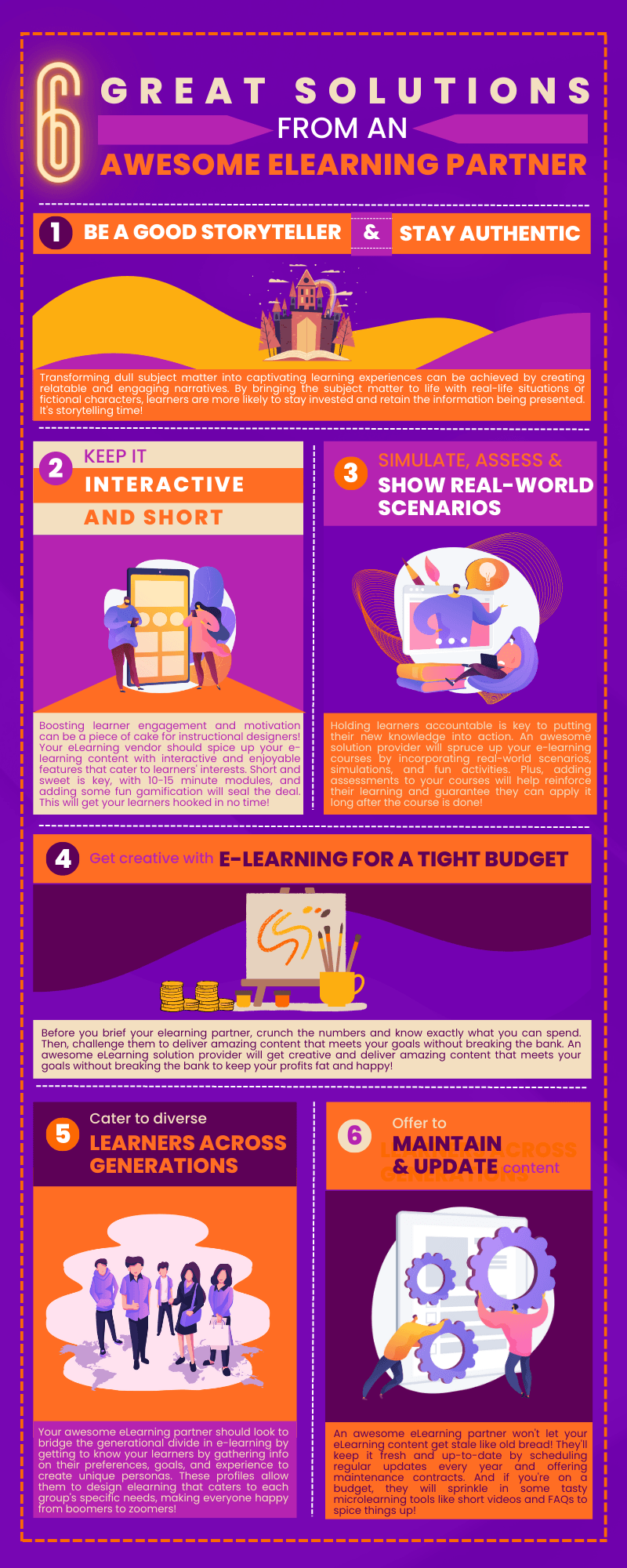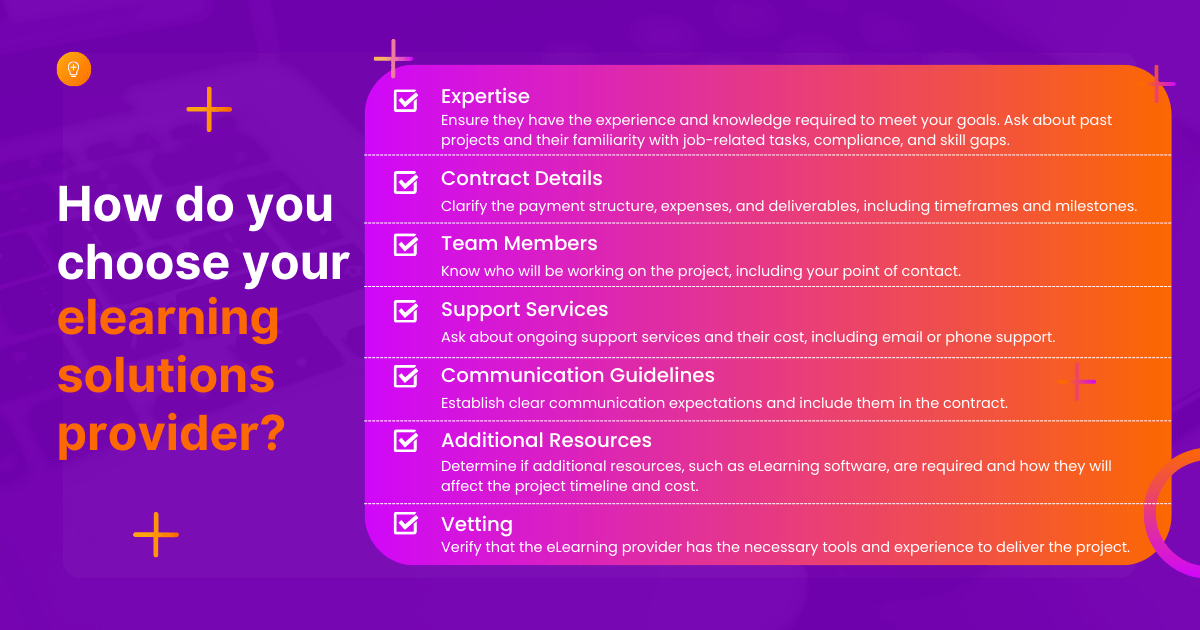[ad_1]
Does Your eLearning Content Provider Support You?
Running a successful training program as a Learning and Development (L&D) professional comes with a multitude of challenges. From tight budgets and limited resources to overcoming resistance against change, the road to effective learning can be bumpy. However, the good news is that you don’t have to face these challenges alone. Having a reliable eLearning content development partner who can help you navigate the obstacles and find practical solutions can make all the difference. In fact, having the right partner by your side can put you in the best possible position to tackle L&D challenges and achieve your learning goals.
6 Challenges eLearning Content Development Partners Should Address
1. Turning Dry Subject Matter Into Captivating eLearning Experiences
Dry and dull subject matter is the bane of every L&D professional’s existence. Transforming content into something engaging and exciting requires a healthy dose of innovation, creativity, and resourcefulness. But sometimes it isn’t so much the subject matter that’s troublesome, but instead, where the information you’re using to build it comes from. With social learning tools, learners can ask questions and receive answers from other users and internal Subject Matter Experts, and then share that knowledge throughout the organization.
Solution
By creating a narrative that is relatable and engaging, learners are more likely to stay invested and retain the information being presented. The story could be based on real-life scenarios or fictional characters, as long as it ties back to the subject matter being taught. In fact, a major pharma company used this method to increase learner satisfaction because learners found the content to be more relevant, authentic, and applicable to their jobs.
2. Struggling With Learner Engagement And Motivation
Unfortunately, not every online learner will be fully invested in the eLearning experience. Distractions, busy schedules, or lack of motivation can make it difficult for learners to actively engage with online learning programs. In today’s fast-paced world, where attention is scarce, learners have access to an overwhelming amount of information.
Solution
To overcome this challenge, Instructional Designers can significantly impact eLearning engagement by designing interactive, enjoyable content that caters to learners’ interests and goals. Try to keep modules short, at 10-15 minutes, and incorporate gamification into the learning experience to increase participant involvement. This way, the learners will see the value in the program and be more likely to participate actively.
3. Ensure Learners Put Their Knowledge Into Practice
When it comes to in-person Instructor-Led Training (ILT), instructors can monitor and provide real-time feedback to learners to make sure they are correctly implementing what they have learned. However, in the case of eLearning, as learners can complete modules from any location without an instructor present, it becomes difficult to monitor their application of new knowledge to their job.
Solution
To tackle this challenge, it’s crucial to consider ways to hold learners accountable for implementing what they have learned through eLearning. One way is to incorporate real-world scenarios or simulations into the eLearning course. This allows learners to apply their knowledge in a practical context and gives them a sense of what it would be like to use the information in a real-world situation. Additionally, providing opportunities for learners to practice what they have learned through activities, exercises, or assessments can reinforce their understanding of the material and help ensure that they can retain and apply it in the future.
4. Dealing With Tight eLearning Budgets
eLearning projects often come with constraints in terms of budget, and it requires creativity and careful planning to make the most of the available resources.
Solution
To ensure success, draft a comprehensive budget that accounts for all expenses before briefing a solution provider. Ask them if they will be able to meet your goals within the budget. This will prevent having to dip into your profit margin to deliver the desired outcome.
5. Offering Learning For Different Generations
Learning content cannot be created in a one-size-fits-all approach. Today’s audience comprises four generations—baby boomers, Gen X, millennials, and Gen Z—each with their own unique characteristics and needs.
Solution
To address this challenge, gather as much information as possible about your learners’ goals, preferences, and backgrounds through surveys or using a learning solution that collects data on their behavior. This information can then be used to create learner personas, allowing you to customize the learning experience based on the experience level and tech-savviness of each group.
6. Keeping eLearning Up-To-Date
eLearning is prone to becoming outdated due to changes in information, processes, and interactions within modules. This constant need for updates and re-creation can be an expensive undertaking, as eLearning content production costs an estimated $200-$900 per minute. Moreover, if organizations neglect to refresh their eLearning content, learners may end up being exposed to outdated information and interactions.
Solution
Schedule regular updates of your eLearning content, every 2-3 years on average. Explore maintenance contracts with your eLearning content vendor. To minimize costs and stay current, consider incorporating cost-effective microlearning tools such as short videos and FAQ pages.
6 Great Solutions From An Awesome eLearning Partner

How Do You Choose Your eLearning Content Development Partner?
eLearning has become an integral part of modern learning and has transformed the way we learn and acquire knowledge. With the increasing demand for eLearning content, choosing the right eLearning content development partner is critical to the success of your eLearning program. However, as your organization evolves and grows, the needs and expectations of your eLearning content may change, and it may be time to reevaluate your current eLearning solutions provider. Before making a decision to change your eLearning content development partner, it’s important to evaluate your current situation and determine what you need from a new partner. Listed below are some key factors to consider when choosing a new partner.
- Expertise
Ensure they have the experience and knowledge required to meet your goals. Ask about past projects and their familiarity with job-related tasks, compliance, and skill gaps. - Contract details
Clarify the payment structure, expenses, and deliverables, including timeframes and milestones. - Team members
Know who will be working on the project, including your point of contact. Consider hosting a pre-project meeting. - Support services
Ask about ongoing support services and their cost, including email or phone support. - Communication guidelines
Establish clear communication expectations and include them in the contract. - Additional resources
Determine if additional resources, such as eLearning software, are required and how they will affect the project timeline and cost. - Vetting
Verify that the eLearning provider has the necessary tools and experience to deliver the project.
A Checklist For Choosing Your eLearning Solutions Provider

When Is It Time To Change Your eLearning Content Development Partner?
Now that we’ve identified the common challenges that Learning and Development professionals face and what to look for in an eLearning service provider, you might be wondering what to do if you’re already working with a provider that doesn’t meet your needs. While finding the right partner is crucial, sometimes even the best partnerships can go sour. We’re at that part of the article where we’ll explore the signs that it’s time to reevaluate your current eLearning partner and how to go about finding a new one that can better meet your needs.
1. Inadequate Quality Of Work
If the quality of work provided by your eLearning content development partner has been consistently poor, it may be time to change to a new partner. Poor quality work can lead to frustration among learners and negatively impact the success of your eLearning program.
2. Inability To Meet Deadlines
If your eLearning content development partner has a history of missing deadlines, it can lead to delays in your eLearning program and negatively impact your organization’s reputation.
3. Lack Of Innovation
If your eLearning content development partner is unable to keep up with the latest trends and innovations in the eLearning industry, it may be time to change to a partner who is more proactive in incorporating the latest technology and pedagogical methods into their work.
4. Communication Breakdown
Effective communication is key to the success of any partnership, and if your eLearning content development partner is unable to effectively communicate with you and your team, it may be time to change to a new partner.
5. Cost Overruns
If the cost of your eLearning content development has consistently exceeded your budget, it may be time to consider a new partner who can provide cost-effective solutions that meet your needs and budget.
Final Thoughts
In conclusion, changing your eLearning content development partner can be a difficult decision, but it is often necessary to ensure the success of your eLearning program. When evaluating your current eLearning content development partner, consider factors such as quality of work, ability to meet deadlines, innovation, effective communication, and cost. By carefully considering these factors, you can make an informed decision on whether it is time to change your eLearning content development partner and find a partner who can better meet your organization’s needs. If you want to develop a tailored eLearning course for your employees, contact specialized eLearning agencies now and discover the wide array of eLearning possibilities.
Image Credits:
- The infographics within the body of the article have been created/supplied by the author.
[ad_2]
Source link

